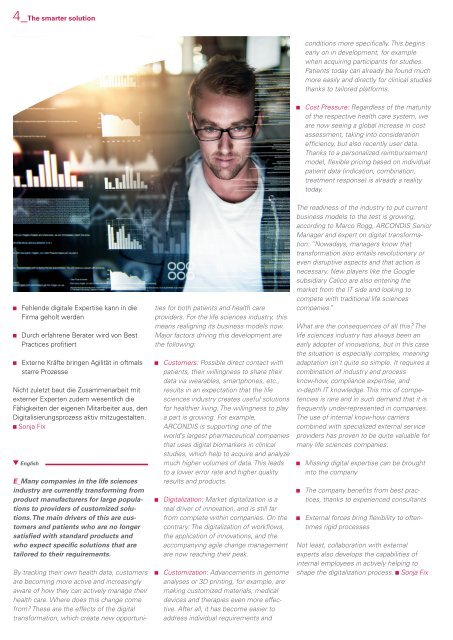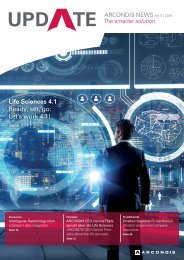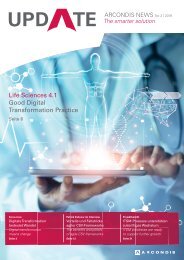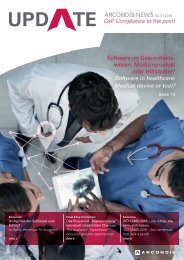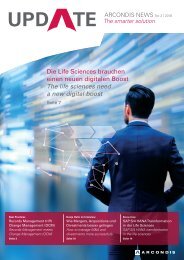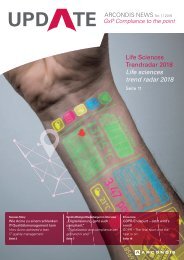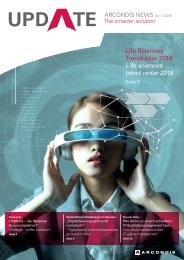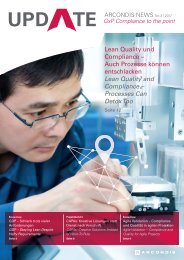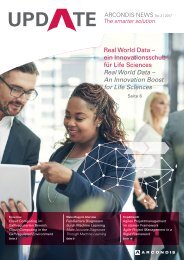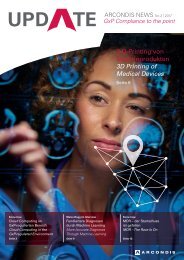ARCONDIS UPDATE No. 03|2017: The smarter solution
ARCONDIS Kundennewsletter für den Themenbereich Business Applications in Life Sciences Unternehmen
ARCONDIS Kundennewsletter für den Themenbereich Business Applications in Life Sciences Unternehmen
Erfolgreiche ePaper selbst erstellen
Machen Sie aus Ihren PDF Publikationen ein blätterbares Flipbook mit unserer einzigartigen Google optimierten e-Paper Software.
4_<strong>The</strong> <strong>smarter</strong> <strong>solution</strong><br />
conditions more specifically. This begins<br />
early on in development, for example<br />
when acquiring participants for studies.<br />
Patients today can already be found much<br />
more easily and directly for clinical studies<br />
thanks to tailored platforms.<br />
Cost Pressure: Regardless of the maturity<br />
of the respective health care system, we<br />
are now seeing a global increase in cost<br />
assessment, taking into consideration<br />
efficiency, but also recently user data.<br />
Thanks to a personalized reimbursement<br />
model, flexible pricing based on individual<br />
patient data (indication, combination,<br />
treatment response) is already a reality<br />
today.<br />
Fehlende digitale Expertise kann in die<br />
Firma geholt werden<br />
Durch erfahrene Berater wird von Best<br />
Practices profitiert<br />
Externe Kräfte bringen Agilität in oftmals<br />
starre Prozesse<br />
Nicht zuletzt baut die Zusammenarbeit mit<br />
externer Experten zudem wesentlich die<br />
Fähigkeiten der eigenen Mitarbeiter aus, den<br />
Digitalisierungsprozess aktiv mitzugestalten.<br />
Sonja Fix<br />
English<br />
E_Many companies in the life sciences<br />
industry are currently transforming from<br />
product manufacturers for large populations<br />
to providers of customized <strong>solution</strong>s.<br />
<strong>The</strong> main drivers of this are customers<br />
and patients who are no longer<br />
satisfied with standard products and<br />
who expect specific <strong>solution</strong>s that are<br />
tailored to their requirements.<br />
By tracking their own health data, customers<br />
are becoming more active and increasingly<br />
aware of how they can actively manage their<br />
health care. Where does this change come<br />
from? <strong>The</strong>se are the effects of the digital<br />
transformation, which create new opportunities<br />
for both patients and health care<br />
providers. For the life sciences industry, this<br />
means realigning its business models now.<br />
Major factors driving this development are<br />
the following:<br />
Customers: Possible direct contact with<br />
patients, their willingness to share their<br />
data via wearables, smartphones, etc.,<br />
results in an expectation that the life<br />
sciences industry creates useful <strong>solution</strong>s<br />
for healthier living. <strong>The</strong> willingness to play<br />
a part is growing. For example,<br />
<strong>ARCONDIS</strong> is supporting one of the<br />
world’s largest pharmaceutical companies<br />
that uses digital biomarkers in clinical<br />
studies, which help to acquire and analyze<br />
much higher volumes of data. This leads<br />
to a lower error rate and higher quality<br />
results and products.<br />
Digitalization: Market digitalization is a<br />
real driver of innovation, and is still far<br />
from complete within companies. On the<br />
contrary: <strong>The</strong> digitalization of workflows,<br />
the application of innovations, and the<br />
accompanying agile change management<br />
are now reaching their peak.<br />
Customization: Advancements in genome<br />
analyses or 3D printing, for example, are<br />
making customized materials, medical<br />
devices and therapies even more effective.<br />
After all, it has become easier to<br />
address individual requirements and<br />
<strong>The</strong> readiness of the industry to put current<br />
business models to the test is growing,<br />
according to Marco Rogg, <strong>ARCONDIS</strong> Senior<br />
Manager and expert on digital transformation:<br />
“<strong>No</strong>wadays, managers know that<br />
transformation also entails revolutionary or<br />
even disruptive aspects and that action is<br />
necessary. New players like the Google<br />
subsidiary Calico are also entering the<br />
market from the IT side and looking to<br />
compete with traditional life sciences<br />
companies.”<br />
What are the consequences of all this? <strong>The</strong><br />
life sciences industry has always been an<br />
early adopter of innovations, but in this case<br />
the situation is especially complex, meaning<br />
adaptation isn’t quite so simple. It requires a<br />
combination of industry and process<br />
know-how, compliance expertise, and<br />
in-depth IT knowledge. This mix of competencies<br />
is rare and in such demand that it is<br />
frequently under-represented in companies.<br />
<strong>The</strong> use of internal know-how carriers<br />
combined with specialized external service<br />
providers has proven to be quite valuable for<br />
many life sciences companies:<br />
Missing digital expertise can be brought<br />
into the company<br />
<strong>The</strong> company benefits from best practices,<br />
thanks to experienced consultants<br />
External forces bring flexibility to oftentimes<br />
rigid processes<br />
<strong>No</strong>t least, collaboration with external<br />
experts also develops the capabilities of<br />
internal employees in actively helping to<br />
shape the digitalization process. Sonja Fix


